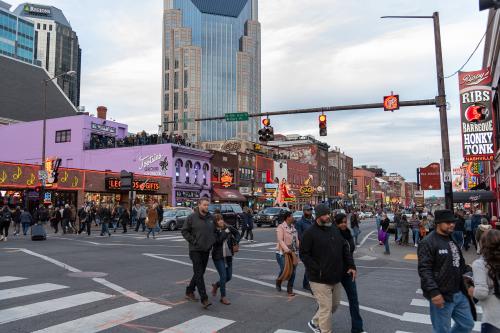The latest edition of MetroMonitor–our ground-up view of the recession and recovery–is out today, looking at economic indicators through the third quarter of 2009. The bottom line: It’s still a big country. Some places had largely recovered by September, while others still hadn’t bottomed out yet. Check out the report for all the details, but here are a few amuse- bouches to whet your appetite:
The manufacturing belt surges… but it may be temporary. One of the big stories over the course of the recession has been the devastation wrought in “auto country,” particularly the upper Midwestern portion in metro areas like Detroit, Grand Rapids, Toledo, and Youngstown. But during the months of July through September, output grew, and job loss slowed, in these and other auto-focused metro areas. Signs point to the cash-for-clunkers program, which seemed to have a hand in boosting auto and auto parts production in these and many other regions across the country. Whether the trend continues into the current quarter, after the program expired, remains to be seen.
Education continues to be a mainstay… but government is slipping. Employment in educational services continued to grow in the third quarter, rising by 1.4 percent overall, and increasing in 77 of the 100 largest metro areas. And many centers of education–Austin, Madison, Syracuse, Washington, D.C.–continue to rank among the best-performing metropolitan areas over the course of the recession. However, government employment–a mainstay over the past two years—showed signs of slipping in a number of metro areas, particularly those including state capitals where budget crises loom. Honolulu, Nashville, Baltimore, Columbia (SC), and Albany saw government job growth in the second quarter turn into job loss in the third quarter.
California metros tumble… but their housing markets may be stabilizing. Four California metro areas–Fresno, Modesto, Oxnard, and San Jose–rank anew among the bottom 20 metro areas in our overall performance index. The reason appears to be spiraling unemployment during the third quarter. To wit, all 11 of the state’s major metro areas had an unemployment rate in September exceeding the national average, from 10.4 percent in San Diego to 15.4 percent in Stockton. On a brighter note, CA metro areas dominated the list of those experiencing falling inventories of bank-owned homes (REOs). This is probably due in significant measure to a shift in timing owing to the state’s new foreclosure law, but sources out there tell us that investor purchases are picking up in ways not yet seen in markets like Las Vegas and Phoenix. The latest Case-Shiller Index provides some further evidence that, at least in the state’s coastal markets, sales prices are rising again.
With President Obama appearing at Brookings last week to talk about jobs, jobs, and, yes, jobs, the latest Monitor reminds us that federal policies to spur their creation them must pay heed to that old real estate chestnut: it’s all about location, location, location.


Commentary
Recovery? Depends Where You Look…
December 16, 2009